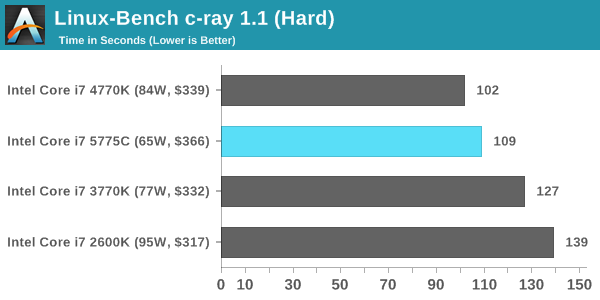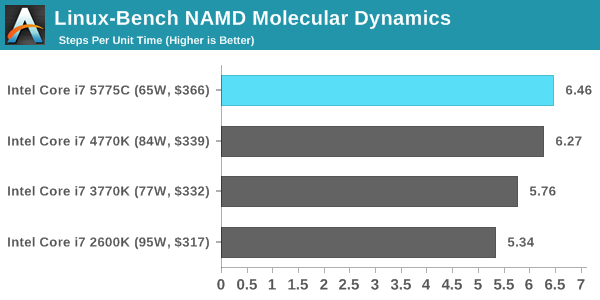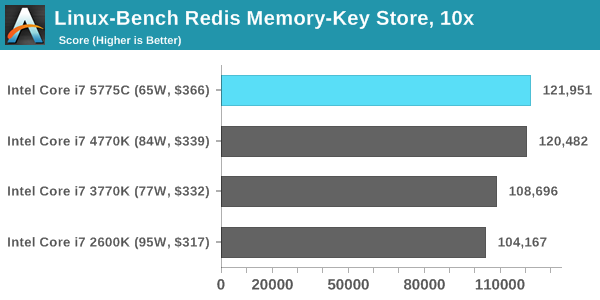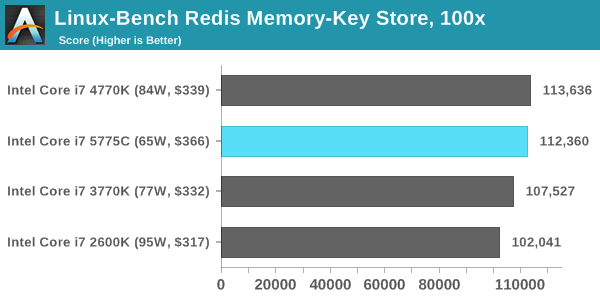The Intel Broadwell Review Part 2: Overclocking, IPC and Generational Analysis
by Ian Cutress on August 3, 2015 8:00 AM ESTLinux Performance
Built around several freely available benchmarks for Linux, Linux-Bench is a project spearheaded by Patrick at ServeTheHome to streamline about a dozen of these tests in a single neat package run via a set of three commands using an Ubuntu 11.04 LiveCD. These tests include fluid dynamics used by NASA, ray-tracing, OpenSSL, molecular modeling, and a scalable data structure server for web deployments. We run Linux-Bench and have chosen to report a select few of the tests that rely on CPU and DRAM speed.
C-Ray: link
C-Ray is a simple ray-tracing program that focuses almost exclusively on processor performance rather than DRAM access. The test in Linux-Bench renders a heavy complex scene offering a large scalable scenario.

NAMD, Scalable Molecular Dynamics: link
Developed by the Theoretical and Computational Biophysics Group at the University of Illinois at Urbana-Champaign, NAMD is a set of parallel molecular dynamics codes for extreme parallelization up to and beyond 200,000 cores. The reference paper detailing NAMD has over 4000 citations, and our testing runs a small simulation where the calculation steps per unit time is the output vector.

NPB, Fluid Dynamics: link
Aside from LINPACK, there are many other ways to benchmark supercomputers in terms of how effective they are for various types of mathematical processes. The NAS Parallel Benchmarks (NPB) are a set of small programs originally designed for NASA to test their supercomputers in terms of fluid dynamics simulations, useful for airflow reactions and design.

Redis: link
Many of the online applications rely on key-value caches and data structure servers to operate. Redis is an open-source, scalable web technology with a b developer base, but also relies heavily on memory bandwidth as well as CPU performance.













121 Comments
View All Comments
bernstein - Monday, August 3, 2015 - link
personally i'd be very interested what intel could do if it would push it's tdp to GPU levels (200-300W) and use that thermal headroom for added GPU EUs.possibly as a "dual die on one interposer" solution, to keep costs down
darckhart - Monday, August 3, 2015 - link
It looks like if you didn't upgrade before, may as well keep waiting. I'm on X58 with a X5650 and it looks like Skylake-E is the best bet for consideration.FlanK3r - Monday, August 3, 2015 - link
Nice review Ian :)TallestJon96 - Monday, August 3, 2015 - link
Not very compelling. All skylake needs to do is be indisputably the fastest, even if only by 10%, and it will seem like a huge upgrade.edlee - Monday, August 3, 2015 - link
yes, anyone with sandy bridge and ivy bridge i5 and i7 already knows not to upgrade cpu anymore.I don't replace SB or IVY, I only add systems for different locations.
The only thing I care about now is GPU improvements, and with DX12 we should see less cpu constraints.
MattVincent - Monday, August 3, 2015 - link
Nice Ian, Anyway we can get you to test the tdp down configuration? Intel states 37w can be achieved at 2.2ghz. As one that is looking this for an htpc processor upgrade the cpu performance is overkill for me, what Im interested in is the integrated graphics.Stuka87 - Monday, August 3, 2015 - link
Well, glad I went with a Devils Canyon haswell instead of waiting for Broadwell to launch this past spring.Welsh_Jester - Monday, August 3, 2015 - link
IPC is getting meaningless, I only upgraded to x99 a few months ago because I knew waiting wouldn't be worth it. And from what I've seen of Skylake and Broadwell, they're not worth the wait. Skylake wasn't even fairly benched in those leaked slides, so it had a 900mhz advantage over the 5820K. Clock both to 4ghz and I bet the Skylake chips are less than 10% faster overall.Imo 5820k is the best bet, 2 more cores where it matters and even DX12 may take advantage of them. Yes people are obviously going to go Broadwell or Skylake just for the IPC increase even if it is a very small increase, or people just want it literally for e-peen benchmarks where you wouldn't even see the difference in real life use.
Welsh_Jester - Monday, August 3, 2015 - link
Also to add to this, I upgraded from x58 and it was completely worth it, over 40% faster in IPC terms.. Plus the new tech of the mobo, SATA 3, much faster bootup and UEFI bios. The stuff coming in Skylake-e will have all the same and is still a ways off, only a small IPC increase difference.Dribble - Monday, August 3, 2015 - link
But so expensive, it's not just the cpu but a decent motherboard is easily twice the price of a non X99 one, and you really want quad channel DDR4 which also costs a lot.